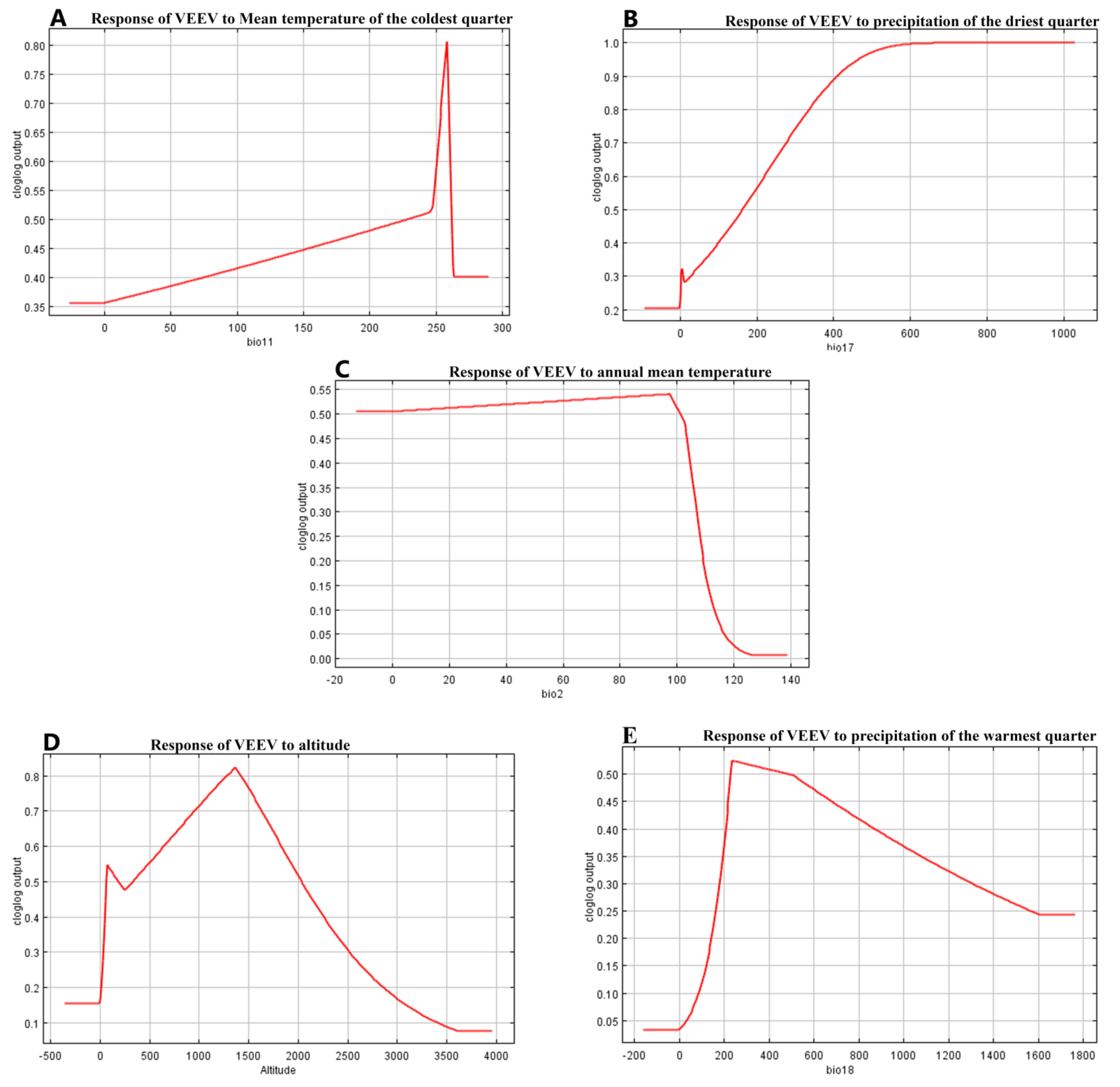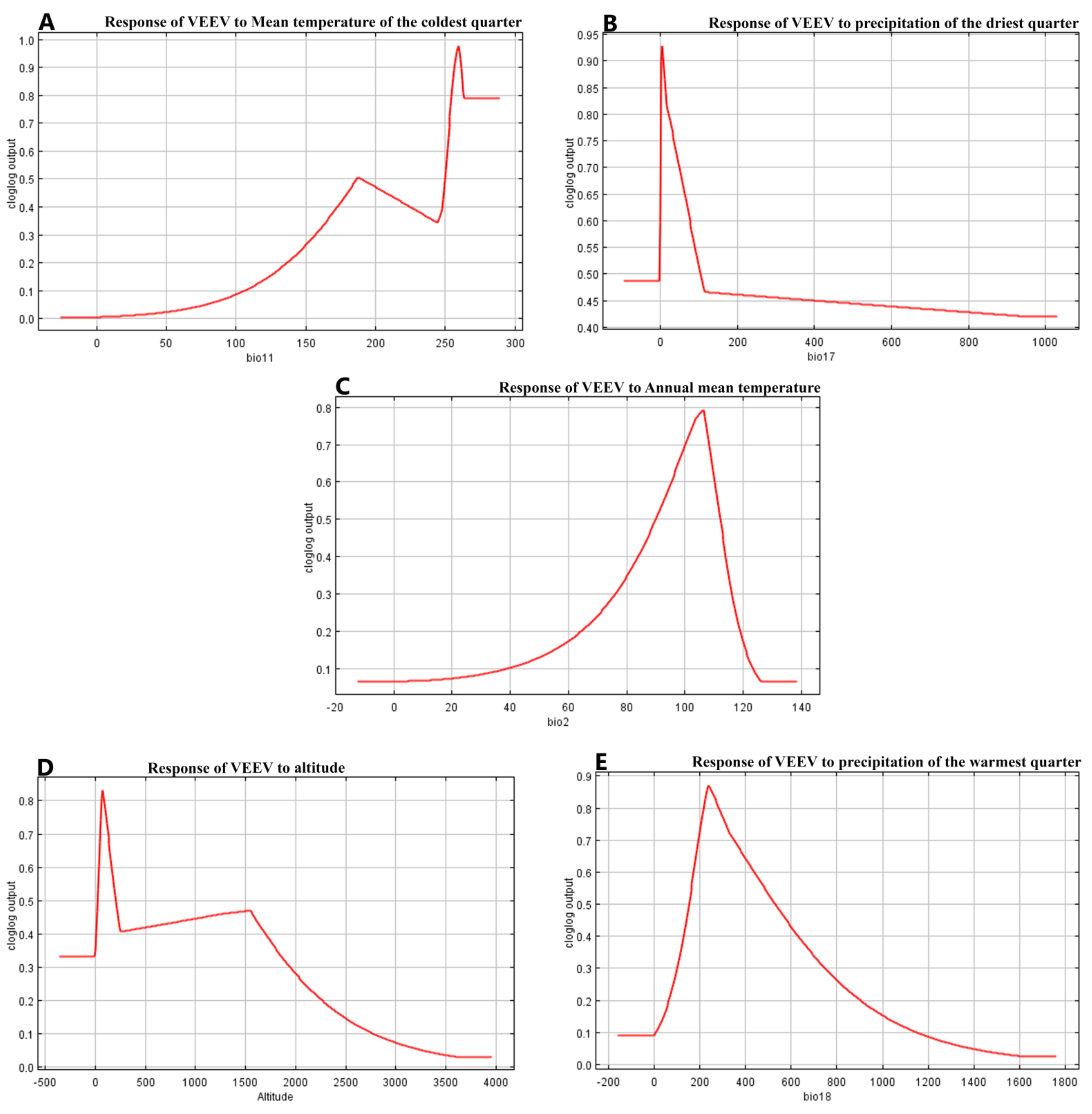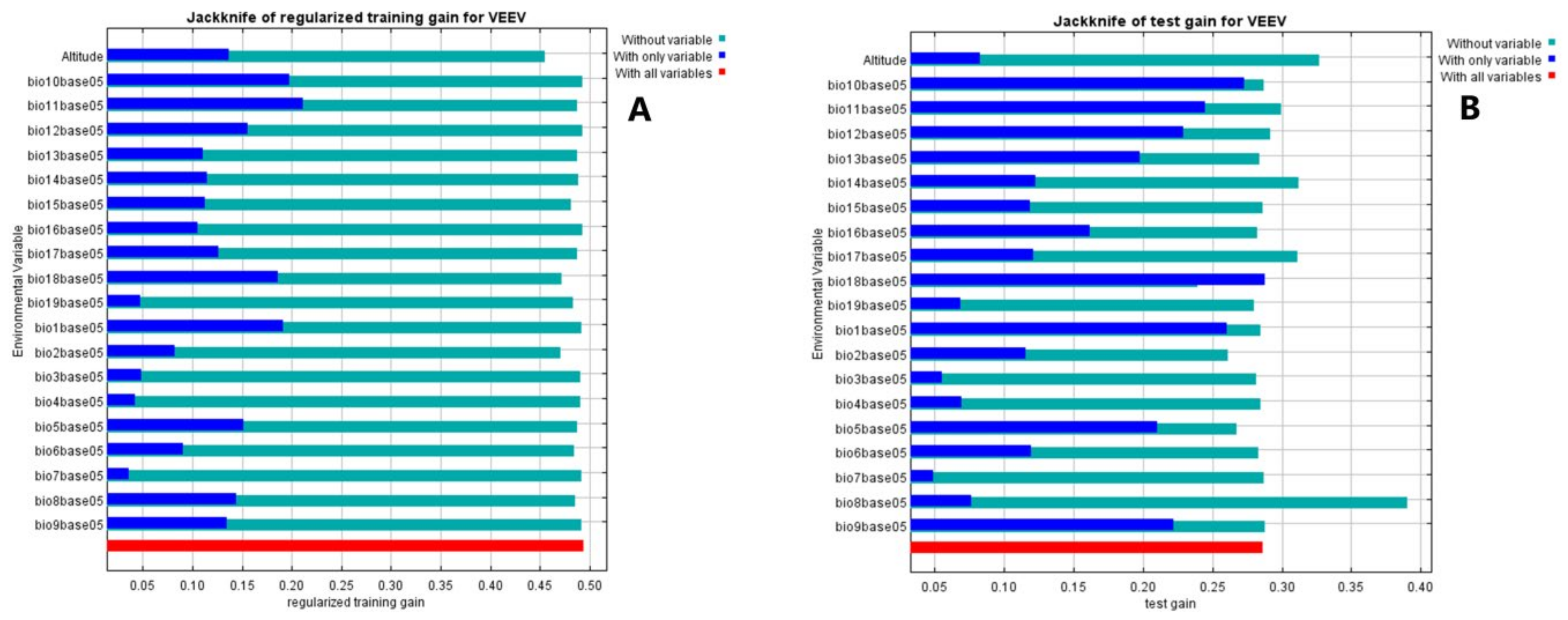An Environmental Niche Model to Estimate the Potential Presence of Venezuelan Equine Encephalitis Virus in Costa Rica
Abstract
1. Introduction
2. Materials and Methods
2.1. Study Area
2.2. Input Data
Environmental Niche Model
3. Results
4. Discussion
5. Conclusions
Supplementary Materials
Author Contributions
Funding
Institutional Review Board Statement
Informed Consent Statement
Data Availability Statement
Acknowledgments
Conflicts of Interest
References
- Cardozo, F.; Konigheim, B.; Albrieu-Llinás, G.; Rivarola, M.E.; Aguilar, J.; Rojas, A.; Quaglia, A.I.; Paez, M.; Guillén, Y.; Diaz, A.; et al. Alphaviruses: Serological Evidence of Human Infection in Paraguay (2012–2013). Vector-Borne Zoonotic Dis. 2018, 18, 266–272. [Google Scholar] [CrossRef] [PubMed]
- Martin, D.H.; Eddy, G.A.; Sudia, W.D.; Reeves, W.C.; Newhouse, V.F.; Johnson, K.M. An epidemiologic study of Venezuelan equine encephalomyelitis in Costa Rica, 1970. Am. J. Epidemiol. 1972, 95, 565–578. [Google Scholar] [CrossRef] [PubMed]
- Guzmán, C.; Calderón, A.; Martinez, C.; Oviedo, M.; Mattar, S. Eco-epidemiology of the Venezuelan equine encephalitis virus in bats of Córdoba and Sucre, Colombia. Acta Trop. 2018, 191, 178–184. [Google Scholar] [CrossRef] [PubMed]
- Medlin, S.; Deardorff, E.R.; Hanley, C.S.; Vergneau-grosset, C.; Siudak-campfield, A.; Dallwig, R.; Travassos, A.; Tesh, R.B.; Martin, M.P.; Weaver, S.C.; et al. Serosurvey of selected arboviral pathogens in free-ranging, two-toed sloths (choloepus hoffmanni) and three-toed sloths (bradypus variegatus) in Costa Rica, 2005–2007. J. Wildl. Dis. 2016, 52, 883–892. [Google Scholar] [CrossRef]
- Weaver, S.C.; Ferro, C.; Barrera, R.; Boshell, J.; Navarro, J.-C. Venezuelan equine encephalitis. Annu. Rev. Entomol. 2004, 49, 141–174. [Google Scholar] [CrossRef]
- Marklewitz, M.; Junglen, S. Evolutionary and ecological insights into the emergence of arthropod-borne viruses Acta Tropica Evolutionary and ecological insights into the emergence of arthropod-borne viruses. Acta Trop. 2018, 190, 52–58. [Google Scholar] [CrossRef]
- Figueiredo, L.T.M. Emergent arboviruses in Brazil. Rev. Soc. Bras. Med. Trop. 2007, 40, 224–229. [Google Scholar] [CrossRef]
- Huang, Y.S.; Higgs, S.; Vanlandingham, D.L.; Colpitts, T.M. Arbovirus-Mosquito Vector-Host Interactions and the Impact on Transmission and Disease Pathogenesis of Arboviruses. Front. Microbiol. 2019, 10, 22. [Google Scholar] [CrossRef]
- Weaver, S.C.; Barrett, A.D.T. Transmission cycles, host range, evolution and emergence of arboviral disease. Nat. Rev. Microbiol. 2004, 2, 789–801. [Google Scholar] [CrossRef]
- León, B.; Käsbohrer, A.; Hutter, S.E.; Baldi, M.; Firth, C.L.; Romero-Zúñiga, J.J.; Jiménez, C. National Seroprevalence and Risk Factors for Eastern Equine Encephalitis and Venezuelan Equine Encephalitis in Costa Rica. J. Equine Vet. Sci. 2020, 92, 103140. [Google Scholar] [CrossRef]
- León, B.; Käsbohrer, A.; Viana, M.; Hutter, S.E.; Baldi, M.; Brenes-Durán, J.; Firth, C.L.; Jiménez, C. IgM passive surveillance of Alphavirus and West Nile Virus in equines with nervous signs from Costa Rica during 2009–2019. 2019. Not submitted to a journal yet. [Google Scholar]
- Sillero, N. An ecological niche is the sum of all the environmental factors acting on the particular organism that occupies a specific area or subdivision of the habitat. There are three different niches: The fundamental, potential and realized niche. Ecol. Model. 2011, 222, 1343–1346. [Google Scholar] [CrossRef]
- Decreto Ejecutivo. División Territorial Administrativa de la República de Costa Rica; Instituto Geográfico Nacional: San José, Costa Rica, 2017; p. 278. [Google Scholar]
- León, B.; Jiménez, C.; González, R.; Ramirez-Carvajal, L. First Complete Coding Sequence of a Venezuelan Equine Encephalitis Virus Strain Isolated from an Equine Encephalitis Case in Costa Rica. Microbiol. Resour. Announc. 2019, 8, 11–13. [Google Scholar] [CrossRef] [PubMed]
- Malavasi, E.O. Atlas Digital de Costa Rica 2008; Repositorio Instituto Tecnológico de Costa Rica, TEC: Cartago, Costa Rica, 2008. [Google Scholar]
- Phillips, S.J.; Anderson, R.P.; Schapire, R.E. Maximum entropy modeling of species geographic distributions. Ecol. Model. 2006, 190, 231–259. [Google Scholar] [CrossRef]
- Elith, J.; Phillips, S.J.; Hastie, T.; Dudík, M.; Chee, Y.E.; Yates, C.J. A statistical explanation of MaxEnt for ecologists. Divers. Distrib. 2011, 17, 43–57. [Google Scholar] [CrossRef]
- Phillips, S.J. A Brief Tutorial on MaxEnt. AT T Res. 2017, 49, 633–641. [Google Scholar]
- Merow, C.; Smith, M.J.; Silander, J.A. A practical guide to MaxEnt for modeling species’ distributions: What it does, and why inputs and settings matter. Ecography (Cop.) 2013, 36, 1058–1069. [Google Scholar] [CrossRef]
- Phillips, S.J.; Anderson, R.P.; Dudík, M.; Schapire, R.E.; Blair, M.E. Opening the black box: An open-source release of MaxEnt. Ecography (Cop.) 2017, 40, 887–893. [Google Scholar] [CrossRef]
- Miller, R.H.; Masuoka, P.; Klein, T.A.; Kim, H.C.; Somer, T.; Grieco, J. Ecological niche modeling to estimate the distribution of japanese encephalitis virus in asia. PLoS Negl. Trop. Dis. 2012, 6, e1678. [Google Scholar] [CrossRef]
- Jiménez, C.; Romero, M.; Baldi, M.; Piche, M.; Alfaro, A.; Chaves, A.; Morales, J.A.; León, B.; Hutter, S. Encefalitis arbovirales en caballos de Costa Rica: 2009–2017. Cienc. Vet. 2018, 36, 27. [Google Scholar] [CrossRef]
- Anderson, R.P.; Lew, D.; Peterson, A.T. Evaluating predictive models of species’ distributions: Criteria for selecting optimal models. Ecol. Model. 2003, 162, 211–232. [Google Scholar] [CrossRef]
- Zimmerman, K.L.; Crisman, M.V. Diagnostic Equine Serology. Vet. Clin. N. Am. Equine Pract. 2008, 24, 311–334. [Google Scholar] [CrossRef] [PubMed]
- Navarro, J.-C.; Carrera, J.-P.; Liria, J.; Auguste, A.J.; Weaver, S.C. Alphaviruses in Latin America and the Introduction of Chikungunya Virus. In Human Virology in Latin America; Springer International Publishing: Cham, Switzerland, 2017; pp. 169–192. [Google Scholar]
- MacNeil, A.; Reed, Z.; Rollin, P.E. Serologic cross-reactivity of human IgM and IgG antibodies to five species of Ebola virus. PLoS Negl. Trop. Dis. 2011, 5, e1175. [Google Scholar] [CrossRef] [PubMed]
- Nyakarahuka, L.; Ayebare, S.; Mosomtai, G.; Kankya, C.; Lutwama, J.; Mwiine, F.N.; Skjerve, E. Ecological Niche Modeling for Filoviruses: A Risk Map for Ebola and Marburg Virus Disease Outbreaks in Uganda. PLoS Curr. Outbreaks 2017, 9, 1–24. [Google Scholar] [CrossRef]
- Koch, L.K.; Cunze, S.; Werblow, A.; Kochmann, J.; Dörge, D.D.; Mehlhorn, H.; Klimpel, S. Modeling the habitat suitability for the arbovirus vector Aedes albopictus (Diptera: Culicidae) in Germany. Parasitol. Res. 2016, 115, 957–964. [Google Scholar] [CrossRef]
- Burch, C.; Loraamm, R.; Unnasch, T.; Downs, J. Utilizing ecological niche modelling to predict habitat suitability of east1. Burch C, Loraamm R, Unnasch, T.; Downs, J. Utilizing ecological niche modelling to predict habitat suitability of eastern equine encephalitis in Florida. Ann. GIS 2020, 26, 133–147. [Google Scholar] [CrossRef]
- Nayar, J.K. Effects of constant and fluctuating temperatures on life span of Aedes taeniorhynchus adults. J. Insect Physiol. 1972, 18, 1303–1313. [Google Scholar] [CrossRef]
- Turell, M.J. Effect of Environmental Temperature on the Vector Competence of Aedes taeniorhynchus for Rift Valley Fever and Venezuelan Equine Encephalitis Viruses. Am. J. Trop. Med. Hyg. 1993, 49, 672–676. [Google Scholar] [CrossRef]
- Adames, A.J. Mosquito studies (Diptera, Culicidae) XXIV. A revision of the crabhole mosquitoes of the genus Deinocerites. Contrib. Am. Entomol. Inst. 1971, 7, 1–154. [Google Scholar]
- Navarro, J.-C.; Medina, G.; Vasquez, C.; Coffey, L.L.; Wang, E.; Suárez, A.; Biord, H.; Salas, M.; Weaver, S.C. Postepizootic Persistence of Venezuelan Equine Encephalitis Virus, Venezuela. Emerg. Infect. Dis. 2012, 11, 1907–1915. [Google Scholar] [CrossRef]
- Peppers, L.L.; Bradley, R.D. Cryptic Species in Sigmodon Hispidus: Evidence from DNA Sequences. J. Mammal. 2000, 81, 332–343. [Google Scholar] [CrossRef]
- Mohlhenrich, J.S. Distribution and Ecology of the Hispid and Least Cotton Rats in New Mexico. J. Mammal. 1961, 42, 13. [Google Scholar] [CrossRef]
- Asigau, S.; Hartman, D.A.; Higashiguchi, J.M.; Parker, P.G. The distribution of mosquitoes across an altitudinal gradient in the Galapagos Islands. J. Vector Ecol. 2017, 42, 243–253. [Google Scholar] [CrossRef]





| Variable | Description of Worldclim 19 Variable Data Represented from 1960–1990, Altitude and Coverage | Contribution % All Variables | Contribution % Only Climatological Variables |
|---|---|---|---|
| Bio01 | Annual mean temperature, °C | 0.3 | 3.1 |
| Bio02 | Mean diurnal range (Mean of monthly (max temp-min temp)), °C | 15.1 | 19.2 |
| Bio03 | Isothermality [(Bio2/Bio7) * 100], °C | 0.8 | 1 |
| Bio04 | Temperature Seasonality (standard deviation * 100), °C | 0 | 0.4 |
| Bio05 | Max temperature of the warmest month, °C | 1.7 | 1.7 |
| Bio06 | Min temperature of the coldest month, °C | 4.7 | 4.9 |
| Bio07 | Temperature annual range (Bio5-Bio6), °C | 3.3 | 2.5 |
| Bio08 | Mean temperature of the wettest quarter1, °C | 3.4 | 2 |
| Bio09 | Mean temperature of the driest quarter, °C | 0.1 | 0.2 |
| Bio10 | Mean temperature of the warmest quarter, °C | 0.4 | 1.3 |
| Bio11 | Mean temperature of the coldest quarter, °C | 32.5 | 27.3 |
| Bio12 | Annual precipitation, mm | 0 | 0.2 |
| Bio13 | Precipitation of the wettest month, mm | 0.6 | 0.6 |
| Bio14 | Precipitation of the driest month, mm | 0.6 | 1.9 |
| Bio15 | Precipitation seasonality (coefficient of variation), mm | 3.1 | 3.1 |
| Bio16 | Precipitation of the wettest quarter, mm | 0.6 | 0.1 |
| Bio17 | Precipitation of the driest quarter, mm | 16.9 | 18.8 |
| Bio18 | Precipitation of the warmest quarter, mm | 6.2 | 8.6 |
| Bio19 | Precipitation of the coldest quarter, mm | 3.8 | 4.1 |
| Altitude | Meters about sea level | 6.6 | - |
Publisher’s Note: MDPI stays neutral with regard to jurisdictional claims in published maps and institutional affiliations. |
© 2020 by the authors. Licensee MDPI, Basel, Switzerland. This article is an open access article distributed under the terms and conditions of the Creative Commons Attribution (CC BY) license (http://creativecommons.org/licenses/by/4.0/).
Share and Cite
León, B.; Jiménez-Sánchez, C.; Retamosa-Izaguirre, M. An Environmental Niche Model to Estimate the Potential Presence of Venezuelan Equine Encephalitis Virus in Costa Rica. Int. J. Environ. Res. Public Health 2021, 18, 227. https://doi.org/10.3390/ijerph18010227
León B, Jiménez-Sánchez C, Retamosa-Izaguirre M. An Environmental Niche Model to Estimate the Potential Presence of Venezuelan Equine Encephalitis Virus in Costa Rica. International Journal of Environmental Research and Public Health. 2021; 18(1):227. https://doi.org/10.3390/ijerph18010227
Chicago/Turabian StyleLeón, Bernal, Carlos Jiménez-Sánchez, and Mónica Retamosa-Izaguirre. 2021. "An Environmental Niche Model to Estimate the Potential Presence of Venezuelan Equine Encephalitis Virus in Costa Rica" International Journal of Environmental Research and Public Health 18, no. 1: 227. https://doi.org/10.3390/ijerph18010227
APA StyleLeón, B., Jiménez-Sánchez, C., & Retamosa-Izaguirre, M. (2021). An Environmental Niche Model to Estimate the Potential Presence of Venezuelan Equine Encephalitis Virus in Costa Rica. International Journal of Environmental Research and Public Health, 18(1), 227. https://doi.org/10.3390/ijerph18010227




